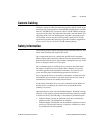
Chapter 2 Hardware Overview of the NI 78xxR
R Series Intelligent DAQ User Manual 2-6 ni.com
Connecting Analog Input Signals
The AI signals for the NI 783xR/784xR/785xR are AI<0..n>+, AI<0..n>–,
AIGND, and AISENSE. For the NI 7830R, n=4. For the
NI 7831R/7833R/784xR/785xR, n=8. The AI<0..n>+ and AI<0..n>–
signals are connected to the eight AI channels of the
NI 783xR/784xR/785xR. For all input modes, the AI<0..n>+ signals are
connected to the positive input of the instrumentation amplifier on each
channel. The signal connected to the negative input of the instrumentation
amplifier depends on how you configure the input mode of the device.
In differential input mode, signals connected to AI<0..n>– are routed to the
negative input of the instrumentation amplifier for each channel. In RSE
input mode, the negative input of the instrumentation amplifier for each
channel is internally connected to AIGND. In NRSE input mode, the
AISENSE signal is connected internally to the negative input of the
instrumentation amplifier for each channel. In DIFF and RSE input modes,
AISENSE is not used.
Caution Exceeding the differential and common-mode input ranges distorts the
input signals. Exceeding the maximum input voltage rating can damage the
NI 783xR/784xR/785xR and the computer. NI is not liable for any damage resulting from
such signal connections. The maximum input voltage ratings are listed in Table A-2,
NI 78xxR I/O Signal Summary.
AIGND is a common AI signal that is routed directly to the ground tie point
on the NI 783xR/784xR/785xR. You can use this signal for a general analog
ground tie point to the NI 783xR/784xR/785xR if necessary.


















